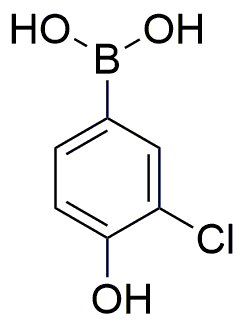3-Chloro-4-hydroxyphenylboronic acid is widely utilized in research focused on:
- Pharmaceutical Development: This compound plays a crucial role in synthesizing various pharmaceuticals, particularly in developing drugs that target specific biological pathways.
- Bioconjugation: It is used in bioconjugation processes to attach biomolecules to surfaces or other molecules, enhancing the efficacy of drug delivery systems.
- Organic Synthesis: The compound serves as a versatile building block in organic synthesis, allowing chemists to create complex molecules with precision.
- Diagnostics: It is employed in the development of diagnostic tools, particularly in assays that require specific binding interactions, improving the accuracy of disease detection.
- Material Science: The compound is used in creating advanced materials, including polymers and coatings, that exhibit enhanced properties such as durability and chemical resistance.
Informations générales
Propriétés
Sécurité et réglementation
Applications
3-Chloro-4-hydroxyphenylboronic acid is widely utilized in research focused on:
- Pharmaceutical Development: This compound plays a crucial role in synthesizing various pharmaceuticals, particularly in developing drugs that target specific biological pathways.
- Bioconjugation: It is used in bioconjugation processes to attach biomolecules to surfaces or other molecules, enhancing the efficacy of drug delivery systems.
- Organic Synthesis: The compound serves as a versatile building block in organic synthesis, allowing chemists to create complex molecules with precision.
- Diagnostics: It is employed in the development of diagnostic tools, particularly in assays that require specific binding interactions, improving the accuracy of disease detection.
- Material Science: The compound is used in creating advanced materials, including polymers and coatings, that exhibit enhanced properties such as durability and chemical resistance.
Documents
Fiches de données de sécurité (FDS)
La FDS fournit des informations de sécurité complètes sur la manipulation, le stockage et l’élimination du produit.
Spécifications du produit (PS)
Le PS fournit une description complète des propriétés du produit, notamment sa composition chimique, son état physique, sa pureté et les exigences de stockage. Il détaille également les plages de qualité acceptables et les applications prévues du produit.
Certificats d'analyse (COA)
Recherchez des certificats d'analyse (COA) en saisissant le numéro de lot du produit. Les numéros de lot et de lot se trouvent sur l'étiquette d'un produit, après les mots « Lot » ou « Lot de fabrication ».
Numéro de catalogue
Numéro de lot/série
Certificats d'origine (COO)
Ce certificat d'exploitation confirme le pays dans lequel le produit a été fabriqué, et détaille également les matériaux et composants utilisés et s'il est issu de sources naturelles, synthétiques ou autres sources spécifiques. Ce certificat peut être requis pour les douanes, le commerce et la conformité réglementaire.
Numéro de catalogue
Numéro de lot/série
Fiches de données de sécurité (FDS)
La FDS fournit des informations de sécurité complètes sur la manipulation, le stockage et l’élimination du produit.
DownloadSpécifications du produit (PS)
Le PS fournit une description complète des propriétés du produit, notamment sa composition chimique, son état physique, sa pureté et les exigences de stockage. Il détaille également les plages de qualité acceptables et les applications prévues du produit.
DownloadCertificats d'analyse (COA)
Recherchez des certificats d'analyse (COA) en saisissant le numéro de lot du produit. Les numéros de lot et de lot se trouvent sur l'étiquette d'un produit, après les mots « Lot » ou « Lot de fabrication ».
Numéro de catalogue
Numéro de lot/série
Certificats d'origine (COO)
Ce certificat d'exploitation confirme le pays dans lequel le produit a été fabriqué, et détaille également les matériaux et composants utilisés et s'il est issu de sources naturelles, synthétiques ou autres sources spécifiques. Ce certificat peut être requis pour les douanes, le commerce et la conformité réglementaire.


